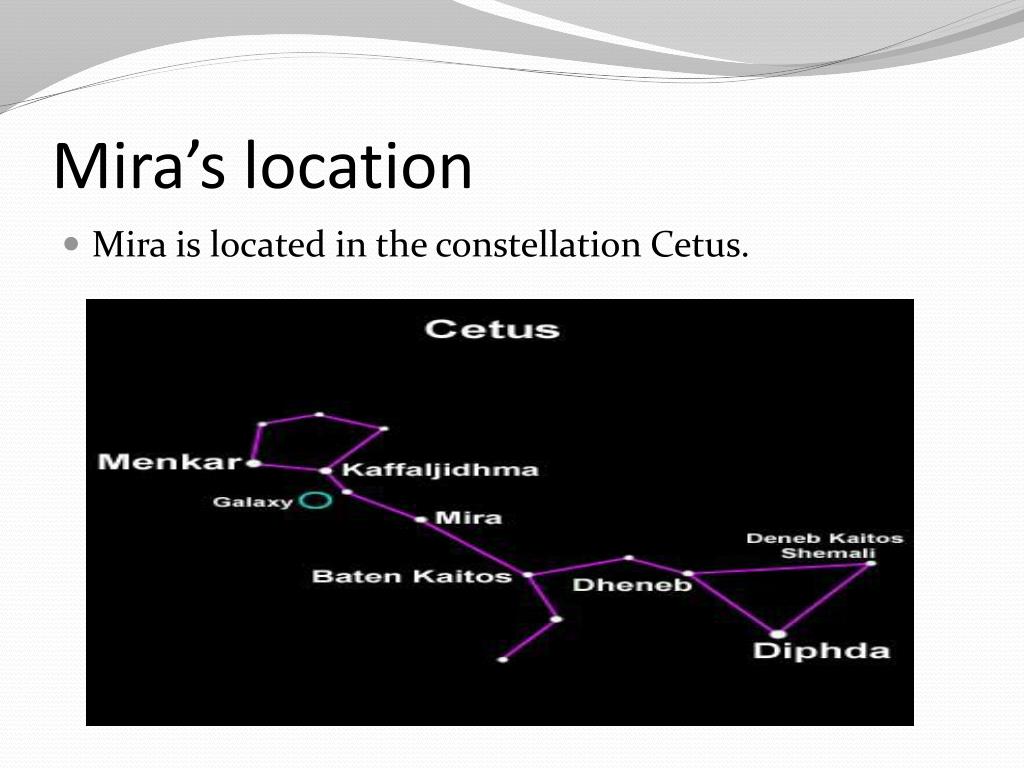

Minima range much less, and have historically been between 8.6 and 10.1, a factor of four times in luminosity. Individual cycles vary too well-attested maxima go as high as magnitude 2.0 in brightness and as low as 4.9, a range almost 15 times in brightness, and there are historical suggestions that the real spread may be three times this or more. In the particular case of Mira, its increases in brightness take it up to about magnitude 3.5 on average, placing it among the brighter stars in the Cetus constellation. The 6,000 to 7,000 known stars of this class are all red giants whose surfaces pulsate in such a way as to increase and decrease in brightness over periods ranging from about 80 to more than 1,000 days. Mira A is a variable star, specifically the prototypical Mira variable. Mira as seen by the Hubble Space Telescope in August 1997

The two stars are currently separated by about 70 astronomical units. Examination of this system by the Chandra X-ray Observatory shows a direct mass exchange along a bridge of matter from the primary to the white dwarf. Such an arrangement of stars is known as a symbiotic system and this is the closest such symbiotic pair to the Sun. This binary star system consists of a red giant (Mira, designated Mira A) undergoing mass loss and a high-temperature white dwarf companion (Mira B) that is accreting mass from the primary. The distance to Mira is uncertain pre- Hipparcos estimates centered on 220 light-years while Hipparcos data from the 2007 reduction suggest a distance of 299 light-years, with a margin of error of 11%. There are three observations from Chinese and Korean archives, in 1596, 1070 and the same year when Hipparchus would have made his observation (134 BC) that are suggestive. The other pre-telescopic Western catalogs of Ptolemy, al-Sufi, Ulugh Beg and Tycho Brahe turn up no mentions, even as a regular star. Karl Manitius, a modern translator of Hipparchus' Commentary on Aratus, has suggested that certain lines from that second-century text may be about Mira. Certainly Algol's history (known for certain as a variable only in 1667, but with legends and such dating back to antiquity showing that it had been observed with suspicion for millennia) suggests that Mira might have been known, too. There is considerable speculation as to whether Mira had been observed prior to Fabricius. The star is estimated to be a six-billion-year-old red giant. Bouillaud's measurement may not have been erroneous: Mira is known to vary slightly in period, and may even be slowly changing over time. Ismail Bouillaud then estimated its period at 333 days, less than one day off the modern value of 332 days. Johannes Hevelius was observing it at the same time and named it Mira in 1662, for it acted like no other known star. In 1638 Johannes Holwarda determined a period of the star's reappearances, eleven months he is often credited with the discovery of Mira's variability. Fabricius assumed it was a nova, but then saw it again on February 16, 1609.

By August 21, however, it had increased in brightness by one magnitude, then by October had faded from view. Observing what he thought was the planet Mercury (later identified as Jupiter), he needed a reference star for comparing positions and picked a previously unremarked third-magnitude star nearby. What is certain is that the variability of Mira was recorded by the astronomer David Fabricius beginning on August 3, 1596.
Baten kaitos mira generator#
Visual light curve of Mira, generated using the AAVSO light curve generator toolĮvidence that the variability of Mira was known in ancient China, Babylon or Greece is at best only circumstantial.


 0 kommentar(er)
0 kommentar(er)
